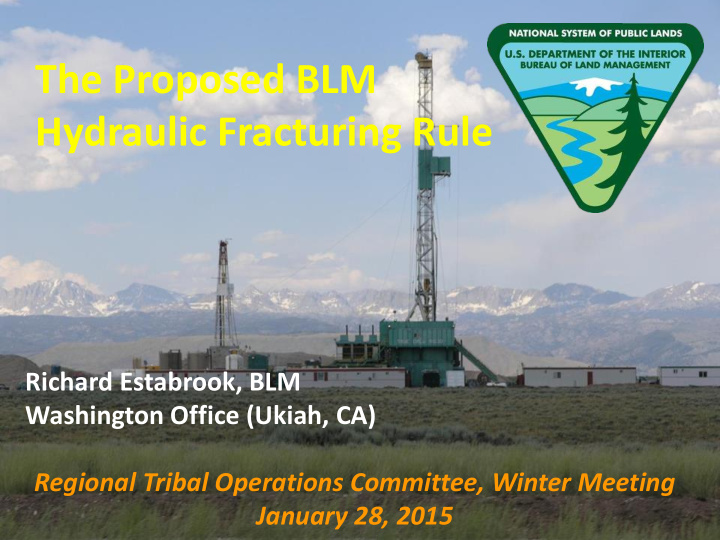



The Proposed BLM Hydraulic Fracturing Rule Richard Estabrook, BLM Washington Office (Ukiah, CA) Regional Tribal Operations Committee, Winter Meeting January 28, 2015
Outline • Overview of BLM jurisdiction, responsibility, and statistics • History and status of BLM hydraulic fracturing regulations • Goals of the regulations • Relationship of BLM hydraulic fracturing regulations and SB4/California regulations
Outline • Overview of BLM jurisdiction, responsibility, and statistics • History and status of BLM hydraulic fracturing regulations • Goals of the regulations • Relationship of BLM hydraulic fracturing regulations and SB4
BLM Jurisdiction and Responsibility (Oil and Gas) • 245 million acres of public land (BLM) • 325 million acres of other federal land • 60 million acres of Indian trust land • 57 million acres of split estate 700 million acres
BLM responsibility: • Leasing • Permitting • Inspection and Enforcement
Federal Onshore Oil and Gas Statistics (FY2013) • 23,000 producing leases • 12.6 million acres of producing leases • 93,000 wells • 135 million bbls/year • 2.6 trillion cubic feet of gas per year • $3 billion in Federal royalty per year
Outline • Overview of BLM jurisdiction, responsibility, and statistics • History and status of BLM hydraulic fracturing regulations • Goals of the regulations • Relationship of BLM hydraulic fracturing regulations and SB4
Existing Regulations “A proposal for further well operations shall be submitted…for approval…prior to commencing operations to perform… nonroutine fracturing jobs.” 43 CFR 3162.3-2(a)
Proposed Regulations May, 2012: • Publish first draft • Received 177,000 comments • Revise draft May, 2013 • Publish second draft • Received 1.35 million comments • Revise draft March, 2015 • Publish final rule (tentative)
Proposed Regulations Most contentious issues: • What is usable water? • Use of cement bond Logs • Pre-disclose chemicals • Trade secret protections • Storage and handling of flowback fluid • Use of State/Tribal regulations • Use of FracFocus for reporting • Baseline water monitoring
Usable Water Existing regulations (Onshore Order 2) • Usable water: Generally < 10,000 ppm TDS • Casing and cementing…shall…protect and/or isolate all usable water zones Existing regulations (3162.5-2(d)) • The operator shall isolate…usable water containing 5,000 ppm or less of TDS… May, 2012 proposal • The operator shall isolate usable water containing 10,000 ppm or less of TDS …
Usable Water, continued May, 2013 proposal • The operator shall isolate usable water containing 10,000 ppm or less of TDS... Includes: • USDWs (non-exempt) • Zones identified by states or tribes • Zones >10,000 if used and could be affected Excludes: • Exempt USDWs • Zones exempted by states or tribes
Cement bond logs May, 2012 proposal • CBL on all casing used to isolate usable water May, 2013 proposal • CEL on a “type well”, unless there are indications of an inadequate cement job
Proposed Regulations Most contentious issues: • What is usable water? • Use of cement bond Logs • Pre-disclose chemicals • Trade secret protections • Storage and handling of flowback fluid • Use of State/Tribal regulations • Use of FracFocus for reporting • Baseline water monitoring
Outline • Overview of BLM jurisdiction, responsibility, and statistics • History and status of BLM hydraulic fracturing regulations • Goals of the regulations • Relationship of BLM hydraulic fracturing regulations and SB4
Proposed Regulations Goals: • Protect usable groundwater • Require BLM review of all HF operations • Ensure wellbore integrity prior to HF • Require monitoring during HF • Protect surface water and the environment • Address flowback fluid handling and disposal • Allow transparency to the public • Reporting of HF • Disclosure of non-proprietary chemicals
Outline • Overview of BLM jurisdiction, responsibility, and statistics • History and status of BLM hydraulic fracturing regulations • Goals of the regulations • Relationship of BLM hydraulic fracturing regulations and SB4
Outline • Overview of BLM jurisdiction, responsibility, and statistics • History and status of BLM hydraulic fracturing regulations • Goals of the regulations • Potential impacts of regulatory changes • Relationship of BLM hydraulic fracturing regulations and SB4
SB4 and BLM Regulations “An operator must comply with both BLM regulations and State laws. For substantive requirements, such as grade of casing or depths of cement, an operator usually complies with both regulations by meeting the stricter or more stringent standard. For procedural requirements, such as obtaining permits and providing notices, the operator must comply with both state and federal rules regardless of which might be considered stricter or more stringent”
Topic BLM* SB4 Permit required X X Pre-disclose chemicals? X Notify landowners X Address “frack hits” X Address wellbore integrity X X Require MIT X X Require monitoring during HF X X Address storage of flowback X X Require report of HF X X *Based on May, 2013 draft rule X = SB4 Well Stimulation Regulations
Topic BLM* SB4 Require post-disclosure X X FracFocus OK X X Provisions for trade secrets X X Includes acidization X Groundwater monitoring X Scientific study X *Based on May, 2013 draft rule
Recommend
More recommend